+ Open data
Open data
- Basic information
Basic information
| Entry | Database: PDB / ID: 8w6o | ||||||
|---|---|---|---|---|---|---|---|
| Title | NaS1 in IN/IN state | ||||||
 Components Components | Solute carrier family 13 member 1 | ||||||
 Keywords Keywords | TRANSPORT PROTEIN / NaS1 / apo state / IN/IN state | ||||||
| Function / homology |  Function and homology information Function and homology informationsodium:sulfate symporter activity / monoatomic anion:sodium symporter activity / Sodium-coupled sulphate, di- and tri-carboxylate transporters / : / sodium ion transport / transmembrane transport / apical plasma membrane / plasma membrane Similarity search - Function | ||||||
| Biological species |  Homo sapiens (human) Homo sapiens (human) | ||||||
| Method | ELECTRON MICROSCOPY / single particle reconstruction / cryo EM / Resolution: 2.9 Å | ||||||
 Authors Authors | Chi, X. / Chen, Y. / Li, Y. / Zhang, Y. / Shen, Y. / Chen, Y. / Wang, Z. / Yan, R. | ||||||
| Funding support |  China, 1items China, 1items
| ||||||
 Citation Citation |  Journal: Sci Adv / Year: 2024 Journal: Sci Adv / Year: 2024Title: Cryo-EM structures of the human NaS1 and NaDC1 transporters revealed the elevator transport and allosteric regulation mechanism. Authors: Ximin Chi / Yiming Chen / Yaning Li / Lu Dai / Yuanyuan Zhang / Yaping Shen / Yun Chen / Tianhao Shi / Haonan Yang / Zilong Wang / Renhong Yan /  Abstract: The solute carrier 13 (SLC13) family comprises electrogenic sodium ion-coupled anion cotransporters, segregating into sodium ion-sulfate cotransporters (NaSs) and sodium ion-di- and-tricarboxylate ...The solute carrier 13 (SLC13) family comprises electrogenic sodium ion-coupled anion cotransporters, segregating into sodium ion-sulfate cotransporters (NaSs) and sodium ion-di- and-tricarboxylate cotransporters (NaDCs). NaS1 and NaDC1 regulate sulfate homeostasis and oxidative metabolism, respectively. NaS1 deficiency affects murine growth and fertility, while NaDC1 affects urinary citrate and calcium nephrolithiasis. Despite their importance, the mechanisms of substrate recognition and transport remain insufficiently characterized. In this study, we determined the cryo-electron microscopy structures of human NaS1, capturing inward-facing and combined inward-facing/outward-facing conformations within a dimer both in apo and sulfate-bound states. In addition, we elucidated NaDC1's outward-facing conformation, encompassing apo, citrate-bound, and -(-amylcinnamoyl) anthranilic acid (ACA) inhibitor-bound states. Structural scrutiny illuminates a detailed elevator mechanism driving conformational changes. Notably, the ACA inhibitor unexpectedly binds primarily anchored by transmembrane 2 (TM2), Loop 10, TM11, and TM6a proximate to the cytosolic membrane. Our findings provide crucial insights into SLC13 transport mechanisms, paving the way for future drug design. | ||||||
| History |
|
- Structure visualization
Structure visualization
| Structure viewer | Molecule:  Molmil Molmil Jmol/JSmol Jmol/JSmol |
|---|
- Downloads & links
Downloads & links
- Download
Download
| PDBx/mmCIF format |  8w6o.cif.gz 8w6o.cif.gz | 169.3 KB | Display |  PDBx/mmCIF format PDBx/mmCIF format |
|---|---|---|---|---|
| PDB format |  pdb8w6o.ent.gz pdb8w6o.ent.gz | 131.6 KB | Display |  PDB format PDB format |
| PDBx/mmJSON format |  8w6o.json.gz 8w6o.json.gz | Tree view |  PDBx/mmJSON format PDBx/mmJSON format | |
| Others |  Other downloads Other downloads |
-Validation report
| Summary document |  8w6o_validation.pdf.gz 8w6o_validation.pdf.gz | 1.3 MB | Display |  wwPDB validaton report wwPDB validaton report |
|---|---|---|---|---|
| Full document |  8w6o_full_validation.pdf.gz 8w6o_full_validation.pdf.gz | 1.3 MB | Display | |
| Data in XML |  8w6o_validation.xml.gz 8w6o_validation.xml.gz | 33.9 KB | Display | |
| Data in CIF |  8w6o_validation.cif.gz 8w6o_validation.cif.gz | 49.7 KB | Display | |
| Arichive directory |  https://data.pdbj.org/pub/pdb/validation_reports/w6/8w6o https://data.pdbj.org/pub/pdb/validation_reports/w6/8w6o ftp://data.pdbj.org/pub/pdb/validation_reports/w6/8w6o ftp://data.pdbj.org/pub/pdb/validation_reports/w6/8w6o | HTTPS FTP |
-Related structure data
| Related structure data |  37330MC 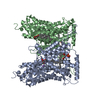 8w6cC 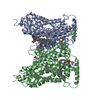 8w6dC 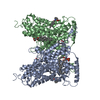 8w6gC 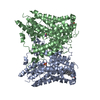 8w6hC 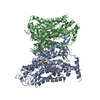 8w6nC 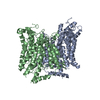 8w6tC M: map data used to model this data C: citing same article ( |
|---|---|
| Similar structure data | Similarity search - Function & homology  F&H Search F&H Search |
- Links
Links
- Assembly
Assembly
| Deposited unit | 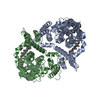
|
|---|---|
| 1 |
|
- Components
Components
| #1: Protein | Mass: 67685.430 Da / Num. of mol.: 2 Source method: isolated from a genetically manipulated source Source: (gene. exp.)  Homo sapiens (human) / Gene: SLC13A1, NAS1, NASI1 / Production host: Homo sapiens (human) / Gene: SLC13A1, NAS1, NASI1 / Production host:  Homo sapiens (human) / References: UniProt: Q9BZW2 Homo sapiens (human) / References: UniProt: Q9BZW2#2: Chemical | ChemComp-NA / #3: Chemical | Has ligand of interest | Y | |
|---|
-Experimental details
-Experiment
| Experiment | Method: ELECTRON MICROSCOPY |
|---|---|
| EM experiment | Aggregation state: PARTICLE / 3D reconstruction method: single particle reconstruction |
- Sample preparation
Sample preparation
| Component | Name: Dimer of NaS1 in IN/IN state / Type: COMPLEX / Entity ID: #1 / Source: RECOMBINANT |
|---|---|
| Source (natural) | Organism:  Homo sapiens (human) Homo sapiens (human) |
| Source (recombinant) | Organism:  Homo sapiens (human) Homo sapiens (human) |
| Buffer solution | pH: 8 |
| Specimen | Embedding applied: NO / Shadowing applied: NO / Staining applied: NO / Vitrification applied: YES |
| Vitrification | Cryogen name: ETHANE |
- Electron microscopy imaging
Electron microscopy imaging
| Experimental equipment |  Model: Titan Krios / Image courtesy: FEI Company |
|---|---|
| Microscopy | Model: FEI TITAN KRIOS |
| Electron gun | Electron source:  FIELD EMISSION GUN / Accelerating voltage: 300 kV / Illumination mode: SPOT SCAN FIELD EMISSION GUN / Accelerating voltage: 300 kV / Illumination mode: SPOT SCAN |
| Electron lens | Mode: BRIGHT FIELD / Nominal defocus max: 2000 nm / Nominal defocus min: 1000 nm |
| Image recording | Electron dose: 50 e/Å2 / Film or detector model: GATAN K3 BIOQUANTUM (6k x 4k) |
- Processing
Processing
| CTF correction | Type: PHASE FLIPPING AND AMPLITUDE CORRECTION |
|---|---|
| 3D reconstruction | Resolution: 2.9 Å / Resolution method: FSC 0.143 CUT-OFF / Num. of particles: 157920 / Symmetry type: POINT |
 Movie
Movie Controller
Controller









 PDBj
PDBj









